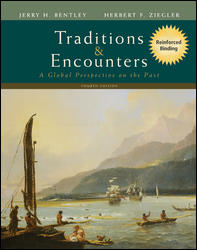Traditions and Encounters, 4th Edition (Bentley)Chapter 13:
THE COMMONWEALTH OF BYZANTIUMOverviewWhile the western half of the Roman empire crumbled and fell, the eastern half, which became known as Byzantium, managed to survive and, mostly, to thrive for a millennium. During its long history, the Byzantine Empire suffered many serious setbacks because of both internal strife and external pressures. Nevertheless, this culture, which blended Roman and Greek traditions, managed to flourish politically, economically, and socially up until the time it began its centuries-long decline culminating in its conquest by the Islamic Ottoman Turks in 1453. Several unique features of the Byzantine civilization contributed to its prosperity: - A strategically located capital city called Constantinople that was one of the largest, most influential, and cosmopolitan urban centers in the world.
- A highly centralized and autocratic governmental structure consisting of an exalted emperor with an aura of divinity and a large and intricate bureaucracy.
- A rich Christian tradition elaborated by the emperor and the patriarchs that eventually evolved into an independent and separate faith referred to as Eastern Orthodox.
- An unusual and effective administration system whereby generals governed over free peasants who received small tracts of land to work in exchange for military service.
- The extension of Byzantine cultural traditions to Eastern Europe and Russia through political, cultural, and economic relations.
 | 
















